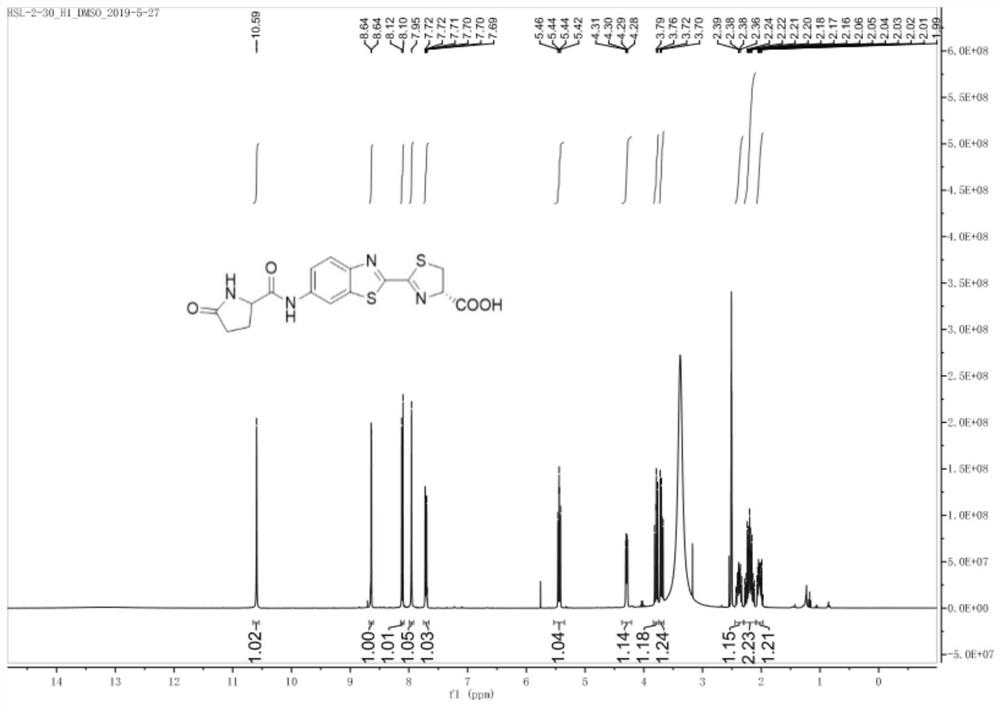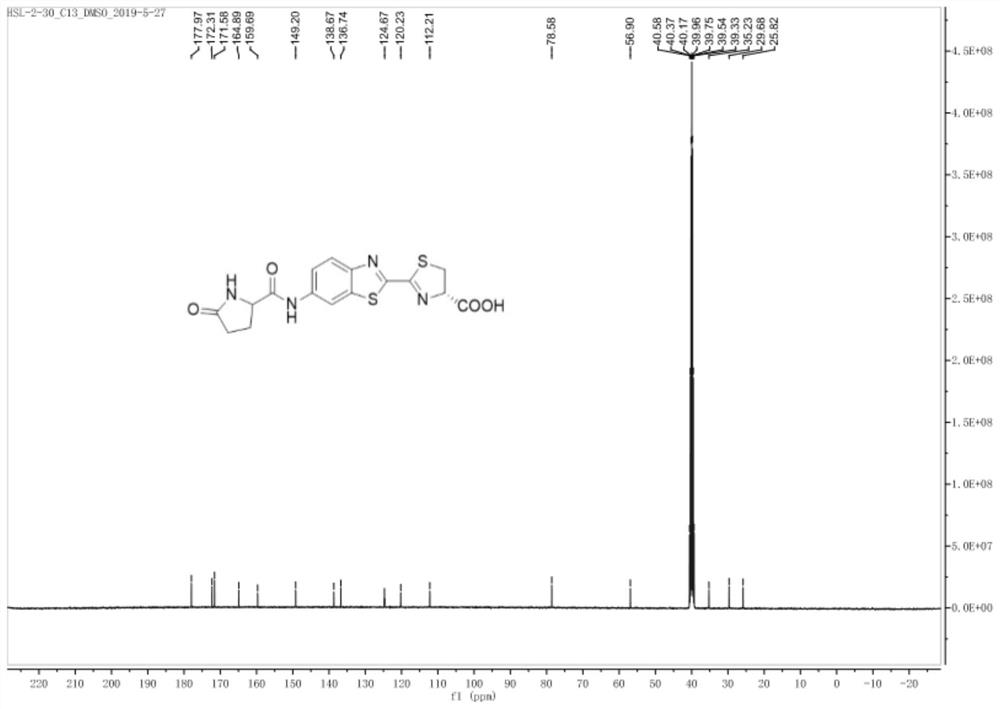A preparation method and application of a bioluminescent probe for detecting pyroglutamate aminopeptidase
A bioluminescence and probe technology, applied in chemiluminescence/bioluminescence, luminescent materials, chemical instruments and methods, etc., can solve the problems of harsh conditions, poor optical probe selectivity, low sensitivity, etc., to achieve low cost, specificity The effect of strong performance and simple preparation method
- Summary
- Abstract
- Description
- Claims
- Application Information
AI Technical Summary
Problems solved by technology
Method used
Image
Examples
Embodiment 1
[0037] Example 1 Preparation of bioluminescence probe CX-1 of the present invention
[0038] Bioluminescent probe CX-1 was prepared according to the following synthetic route:
[0039]
[0040] (1) Dissolve Boc-L-pyroglutamic acid (3.0mmol, 500mg) in 10mL of anhydrous acetonitrile, and under the protection of nitrogen, add dropwise 5mL of anhydrous acetonitrile ), isobutyl chloroformate (3.0mmol, 285μL), 2-cyano-6-aminobenzothiazole (3.0mmol, 405mg) were reacted at 25°C for 5h, then spin-dried, extracted, and separated by column chromatography (elution The agent is petroleum ether and ethyl acetate with a volume ratio of 1:5) to obtain solid powder intermediate 3, 1 H NMR (400MHz, DMSO) δ10.81 (s, 1H), 8.76 (d, J = 1.8Hz, 1H), 8.23 (d, J = 9.0Hz, 1H), 7.78 (dd, J = 9.0, 2.0Hz ,1H),4.73(dd,J=9.0,3.5Hz,1H),2.50–2.26(m,3H),1.96(ddd,J=17.4,8.4,4.3Hz,1H),1.36(s,9H); 13 C NMR (101MHz, DMSO) δ174.02, 171.11, 149.40, 148.30, 139.70, 137.23, 135.81, 125.40, 121.22, 114.01, 112....
experiment example 1
[0045] In Vitro Detection of Experimental Example 1 Probe CX-1 Activity
[0046] In a black 96-well plate, add 100 μM probe CX-1 of the present invention, pyroglutamate aminopeptidase solution with different concentration gradients (see details for specific concentrations) image 3 ), with a volume of 100uL each, incubated at 37°C for 30min, then added 50μL of ATP-containing luciferase mixed solution (ATP1.1mg / ml, luciferase 20ug / ml), and each concentration was replicated three times. The holes were then imaged under an intravital imager.
[0047] The result is as image 3 As shown, with the increase of the concentration of pyroglutamate aminopeptidase, the intensity of bioluminescence gradually increased. In the in vitro detection, the bioluminescence intensity and pyroglutamate aminopeptidase showed a good linear relationship within a certain concentration range.
[0048] The above results show that the probe CX-1 of the present invention has good detection sensitivity an...
experiment example 2
[0050] Selective detection of experimental example 2 probes
[0051] In a black 96-well plate, add 100 uL of 100 μM probe CX-1 solution and different analyte solutions (Blank, KCl, ZnCl 2 , CaCl 2 , MgCl 2 , CuCl 2 , NaClO, Glucose, Cys, GSH, Try, Ala, Thr, Lys, Ser, Asp, Vitamin C, Glu, Esterase, Trypsin, Thrombin, V8, PGP (pyroglutamate aminopeptidase); each volume 100uL, 100μM ) were incubated at 37°C for 30 min, 50 μL of ATP-containing luciferase solution (ATP 1.1 mg / ml, luciferase 20 ug / ml) was added to each well, and immediately imaged under an in vivo imager.
[0052] The result is as Figure 4 As shown, among various in vivo enzymes and ionic compounds, only pyroglutamate aminopeptidase caused strong bioluminescence, and other in vivo enzymes and ionic compounds hardly produced obvious bioluminescent signals.
[0053] The experimental results show that the probe CX-1 can specifically select and detect pyroglutamate aminopeptidase without being interfered by other ...
PUM
 Login to View More
Login to View More Abstract
Description
Claims
Application Information
 Login to View More
Login to View More - R&D
- Intellectual Property
- Life Sciences
- Materials
- Tech Scout
- Unparalleled Data Quality
- Higher Quality Content
- 60% Fewer Hallucinations
Browse by: Latest US Patents, China's latest patents, Technical Efficacy Thesaurus, Application Domain, Technology Topic, Popular Technical Reports.
© 2025 PatSnap. All rights reserved.Legal|Privacy policy|Modern Slavery Act Transparency Statement|Sitemap|About US| Contact US: help@patsnap.com



